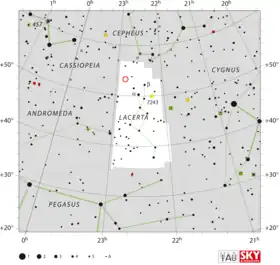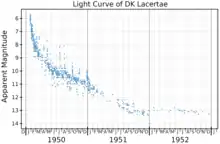DK Lacertae
DK Lacertae (Nova Lacertae 1950) was a nova, which lit up in the constellation Lacerta in 1950. The nova was discovered by Charles Bertaud of the Paris Observatory on a photographic plate taken on 23 January 1950. At the time of its discovery, it had an apparent magnitude of 6.1.[6] DK Lacertae reached peak magnitude 5.0, making it easily visible to the naked eye.[2]
 | |
| Observation data Epoch J2000 Equinox J2000 | |
|---|---|
| Constellation | Lacerta |
| Right ascension | 22h 49m 46.93149s[1] |
| Declination | +53° 17′ 19.7993″[1] |
| Apparent magnitude (V) | 5.0 – 15.5[2] (var.) |
| Characteristics | |
| Variable type | classical nova[2] |
| Astrometry | |
| Proper motion (μ) | RA: −1.945[1] mas/yr Dec.: −1.722[1] mas/yr |
| Parallax (π) | 0.4026 ± 0.0697 mas[1] |
| Distance | 2517+788 −261[3] pc |
| Details | |
| DK Lac B | |
| Mass | 1.03[4] M☉ |
| Other designations | |
| Database references | |
| SIMBAD | data |

DK Lacertae's post-eruption light curve was remarkable for the large number of outbursts of a magnitude or more which occurred in the months after the main nova event.[7][8] Strope et al. (2010) reported that there were 14 of these "jitters" in the light curve, and they used this star as the prototype object for their type J light curve class.[9] It took about 60 days for the nova to drop from peak brightness by 3 magnitudes, which makes DK Lacertae a "fast" nova.[10]
X-ray emission has been detected from this system.[11]
All novae are binary stars, with a "donor" star orbiting a white dwarf. The donor star is so close to the white dwarf that matter is transferred from the donor to an accretion disk surrounding the white dwarf. In the case of DK Lacertae, Shara et al. (2018) estimate that the white dwarf has a mass of 1.03M☉ and the donor star is transferring 3.4 × 10−8 M☉ yr−1 to the accretion disk.[4] The orbital periods of nova are typically a few hours, but no photometric periodicity on that timescale has been found for DK Lac, suggesting that we are viewing the accretion disk nearly face-on.[12]
A faint shell was detected around the source in 1995, with a radius of about 2.0″–2.5″,[13] but later observations with the Hubble Space Telescope failed to detect the shell.[14]
References
- Brown, A. G. A.; et al. (Gaia collaboration) (August 2018). "Gaia Data Release 2: Summary of the contents and survey properties". Astronomy & Astrophysics. 616. A1. arXiv:1804.09365. Bibcode:2018A&A...616A...1G. doi:10.1051/0004-6361/201833051.
- Samus', N. N; Kazarovets, E. V; Durlevich, O. V; Kireeva, N. N; Pastukhova, E. N (2017). "General catalogue of variable stars: Version GCVS 5.1". Astronomy Reports. 61 (1): 80. Bibcode:2017ARep...61...80S. doi:10.1134/S1063772917010085. S2CID 125853869.
- Schaefer, Bradley E. (December 2018). "The distances to Novae as seen by Gaia". Monthly Notices of the Royal Astronomical Society. 481 (3): 3033–3051. arXiv:1809.00180. Bibcode:2018MNRAS.481.3033S. doi:10.1093/mnras/sty2388.
- Shara, Michael M.; et al. (June 2018). "The Masses and Accretion Rates of White Dwarfs in Classical and Recurrent Novae". The Astrophysical Journal. 860 (2): 11. arXiv:1804.06880. Bibcode:2018ApJ...860..110S. doi:10.3847/1538-4357/aabfbd. S2CID 55851634. 110.
- "DK Lac". SIMBAD. Centre de données astronomiques de Strasbourg. Retrieved 3 September 2018.
- Duerbeck, Hilmar W. (March 1987). "A Reference Catalogue and Atlas of Galactic Novae". Space Science Reviews. 45 (1–2): 1–14. Bibcode:1987SSRv...45....1D. doi:10.1007/BF00187826. S2CID 115854775.
- Bochníček, Z. (February 1951). "Light Curve of Nova DK Lacertae 1950". Bulletin of the Astronomical Institutes of Czechoslovakia. 2: 88. Bibcode:1951BAICz...2...88B.
- Ribbe, John (February 1951). "The Light-Curve of Nova Lacertae 1950". Publications of the Astronomical Society of the Pacific. 63 (370): 39. Bibcode:1951PASP...63...39R. doi:10.1086/126314.
- Strope, Richard J.; Schaefer, Bradley E.; Henden, Arne A. (July 2010). "Catalog of 93 Nova Light Curves: Classification and Properties". The Astronomical Journal. 140 (1): 34–62. arXiv:1004.3698. Bibcode:2010AJ....140...34S. doi:10.1088/0004-6256/140/1/34.
- Selvelli, Pierluigi; Gilmozzi, Roberto (February 2019). "A UV and optical study of 18 old novae with Gaia DR2 distances: mass accretion rates, physical parameters, and MMRD". Astronomy & Astrophysics. 622: A186. arXiv:1903.05868. Bibcode:2019A&A...622A.186S. doi:10.1051/0004-6361/201834238.
- Boardman, S. F.; et al. (January 2016). "X-ray detection of the old nova DK Lacertae". The Astronomer's Telegram. 8610: 1. Bibcode:2016ATel.8610....1B.
- Honeycutt, R.K.; Kafka, S.; Jacobson, H.; Henden, A.A.; Hoffman, D.; Maxwell, T.; Robertson, J.W.; Croxall, K. (April 2011). "The 2001-2003 Low State of Nova Lacertae 1950 (DK Lac)". The Astronomical Journal. 141 (4): 122. arXiv:1102.3759. Bibcode:2011AJ....141..122H. doi:10.1088/0004-6256/141/4/122.
- Slavin, A.J.; O'Brien, T.J.; Dunlop, J.S. (September 1995). "A deep optical imaging study of the nebular remnants of classical novae". Monthly Notices of the Royal Astronomical Society. 276 (2): 353–371. Bibcode:1995MNRAS.276..353S. doi:10.1093/mnras/276.2.353.
- Gill, C. D.; O'Brien, T. J. (May 2000). "Hubble Space Telescope imaging and ground-based spectroscopy of old nova shells - I. FH Ser, V533 Her, BT Mon, DK Lac and V476 Cyg". Monthly Notices of the Royal Astronomical Society. 314 (1): 175–182. arXiv:astro-ph/0001092. Bibcode:2000MNRAS.314..175G. doi:10.1046/j.1365-8711.2000.03342.x. S2CID 119433788.